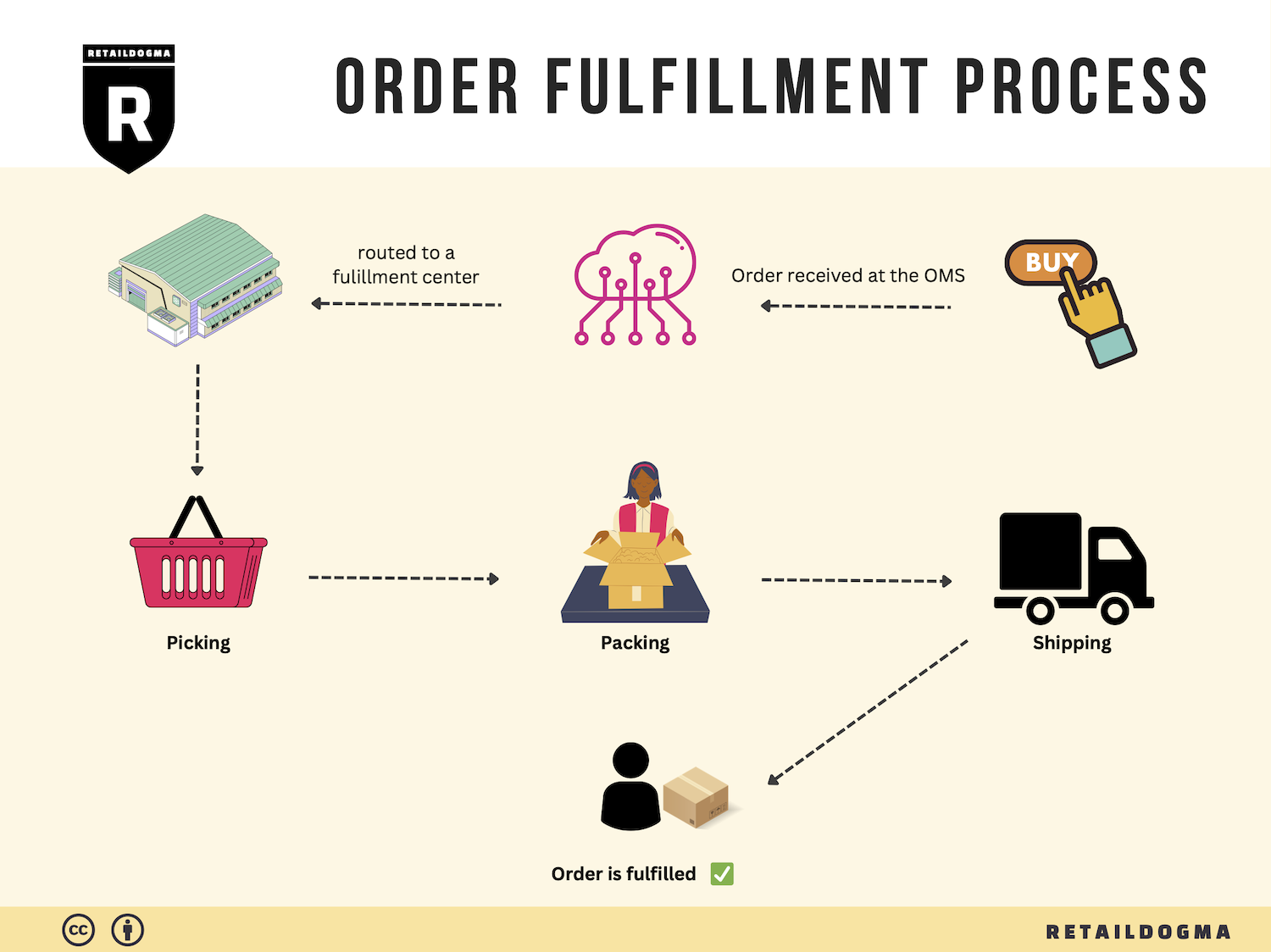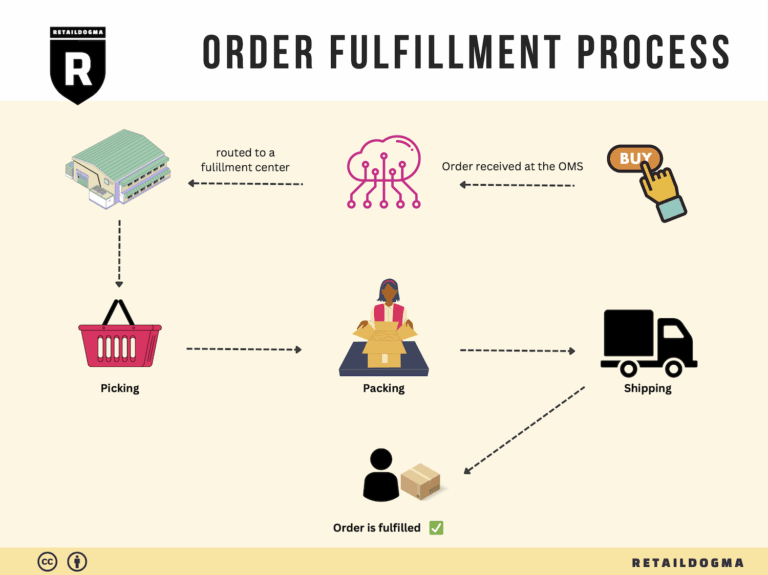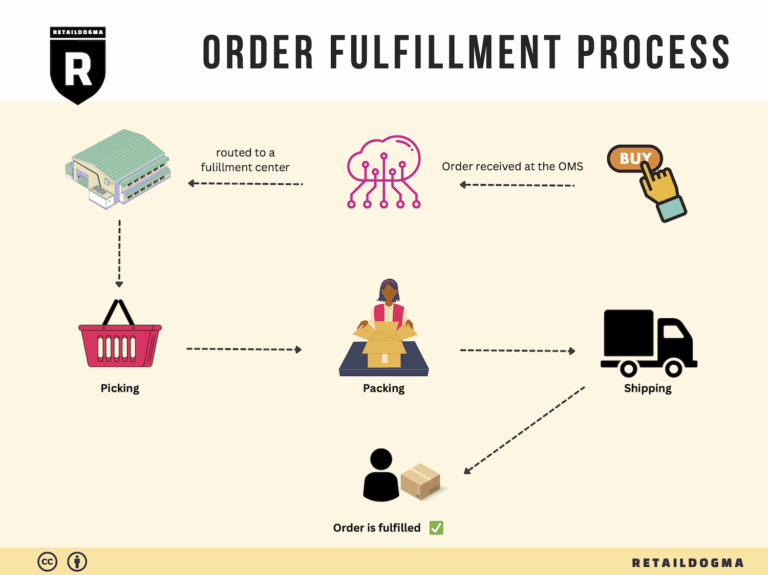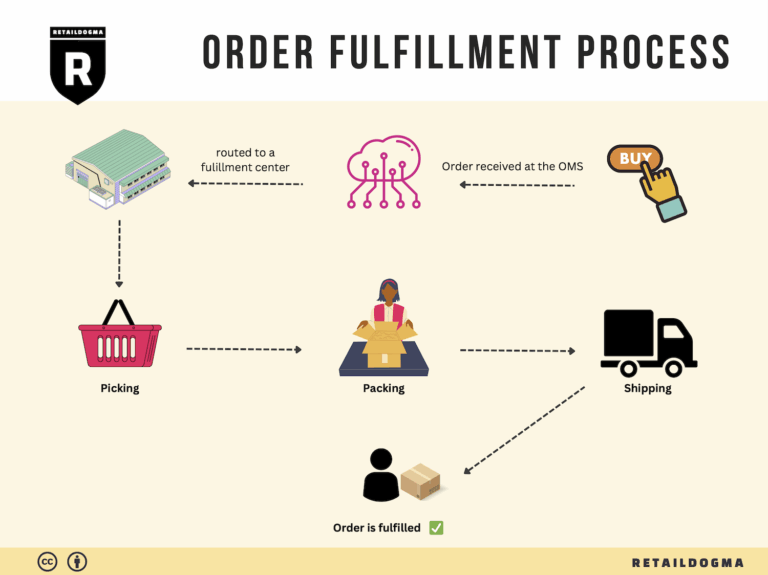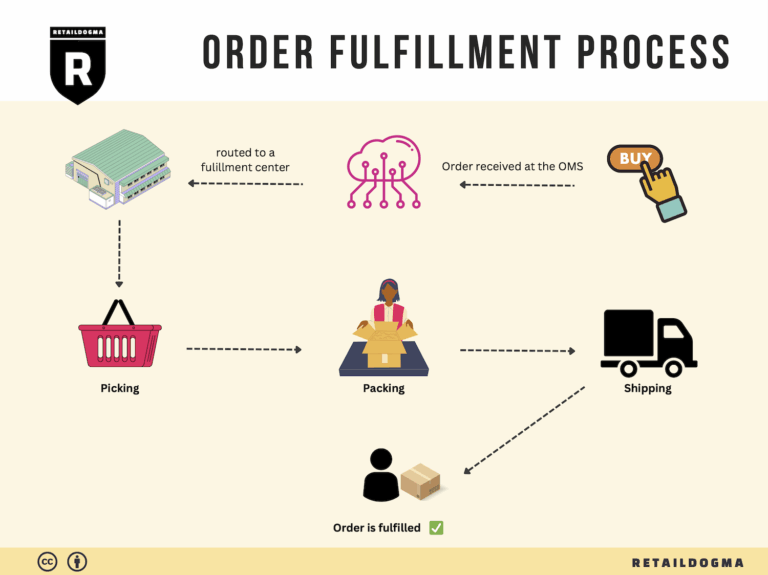What Is A Fulfillment Center? A Complete Guide (2025)
What is E-commerce Fulfillment? An Introduction for Growing Businesses
Managing an e-commerce business can be an exhilarating journey, but it often comes with its fair share of challenges. One of the most common pain points for growing online retailers is the overwhelming task of packing and shipping orders. As your sales increase, so does the complexity of logistics. Without a solid fulfillment strategy in place, you may find yourself buried under boxes, packing materials, and a growing list of shipping deadlines.
Understanding Fulfillment
At its core, e-commerce fulfillment is the process of getting a product from your warehouse or supplier to your customer’s doorstep. This involves not just picking and packing items, but also managing inventory, processing orders, and ensuring timely delivery. In a world where customer expectations for fast shipping and hassle-free returns are higher than ever, effective fulfillment can be the differentiator that sets your business apart from the competition.
What This Guide Covers
This guide aims to demystify the world of e-commerce fulfillment, providing you with the knowledge and tools necessary to streamline your logistics operations. We will explore different fulfillment models, including:
- Third-Party Logistics (3PL): Outsourcing your fulfillment needs to specialized providers who handle storage, packing, and shipping on your behalf.
- Fulfillment by Amazon (FBA): Leveraging Amazon’s vast logistics network to manage your inventory and shipping, while gaining access to their customer base.
We will also delve into the core services offered by fulfillment centers, such as inventory management, order processing, and returns handling. Understanding these services will help you identify what you need from a fulfillment partner.
Choosing the Right Partner
Selecting the right fulfillment partner is crucial for your business’s growth. We will discuss key factors to consider, including location, technology integration, and customer service. Knowing what to look for can save you time and money, as well as enhance your overall customer experience.
Pricing Insights
Lastly, we will break down the various pricing structures associated with fulfillment services. From storage fees to shipping costs, understanding the financial implications will empower you to make informed decisions that align with your budget and growth goals.
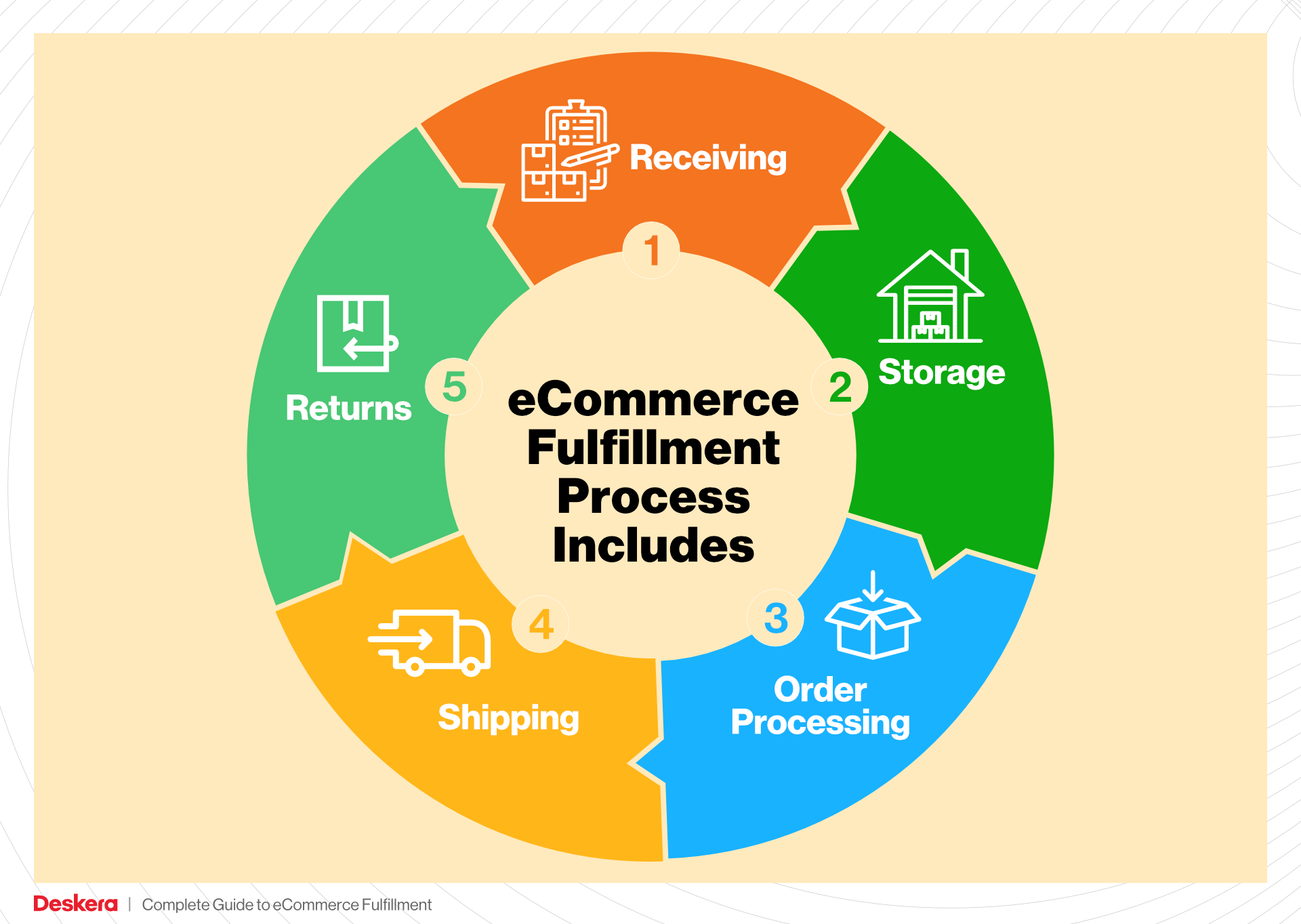
Empowering Smart Decisions
The ultimate goal of this guide is to empower you, the business owner, to make smart decisions about your logistics strategy. With the right fulfillment approach, you can focus on scaling your business while ensuring that your customers receive their orders promptly and efficiently. Let’s dive into the world of e-commerce fulfillment and unlock the potential of your growing business.
What You’ll Learn In This Guide
- What is E-commerce Fulfillment? An Introduction for Growing Businesses
- The Order Fulfillment Process: From ‘Buy’ Button to Customer’s Door
- Comparing Fulfillment Models: In-House vs. 3PL vs. Dropshipping
- A Deep Dive into Amazon FBA: Pros, Cons, and Who It’s For
- Core Services Offered by Fulfillment Centers
- How to Choose a Fulfillment Partner: A 6-Point Checklist
- Understanding Fulfillment Pricing: A Breakdown of Common Fees
- Frequently Asked Questions (FAQs) about Fulfillment
- Conclusion: Is Outsourcing Fulfillment the Right Move for Your Business?
- Important Disclaimer
The Order Fulfillment Process: From ‘Buy’ Button to Customer’s Door
1. Receiving Inventory
The order fulfillment process begins with receiving inventory from suppliers or manufacturers. This step is critical as it establishes the foundation of your inventory management. During this phase, products are checked for accuracy against purchase orders, and any discrepancies or damages are documented.
This step is crucial for maintaining accurate stock levels and ensuring that the right products are available for customers. A key term associated with this step is SKU (Stock Keeping Unit), which helps in tracking inventory items uniquely. By using SKUs, businesses can streamline the receiving process, enhance inventory accuracy, and improve overall operational efficiency.
Implementing a robust receiving system can help minimize errors, reduce returns, and ultimately enhance customer satisfaction. This not only sets the tone for the entire fulfillment process but also impacts future steps, such as storage and order processing.
2. Warehouse Storage
Once inventory is received, it must be stored efficiently within the warehouse. This stage involves organizing products in a manner that maximizes space and facilitates easy access. Effective warehouse storage is vital for reducing retrieval times and ensuring that products are easily found when needed.
The importance of this step cannot be overstated; a well-organized warehouse can significantly affect order fulfillment speed and accuracy. A common term used in this context is bin location, which refers to the specific area within the warehouse designated for each SKU. By clearly labeling bin locations, businesses can enhance picking efficiency and minimize the time spent searching for products.
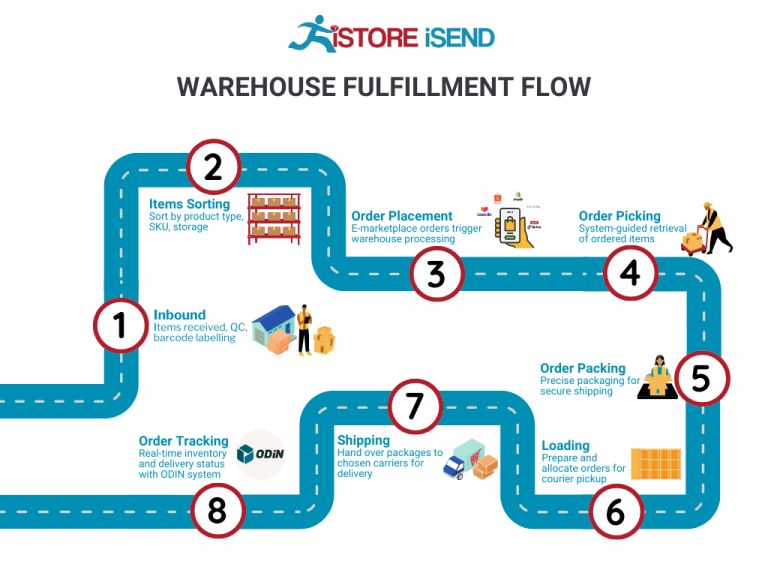
Investing in warehouse management systems (WMS) can further optimize storage practices, allowing for real-time inventory tracking and improved stock management. This strategic approach lays the groundwork for a seamless order picking process.
3. Order Picking
Order picking is the process of retrieving items from storage to fulfill customer orders. This step is critical as it directly impacts order accuracy and fulfillment speed. Efficient order picking can enhance customer satisfaction by ensuring that the right products are delivered on time.
During this phase, employees typically use pick lists, which are generated based on customer orders. These lists guide pickers to the correct bin locations, ensuring that items are collected efficiently. There are various picking methods, including single order picking, batch picking, and wave picking, each suitable for different types of operations.
Optimizing the order picking process can lead to reduced labor costs and faster turnaround times. For businesses looking to scale, investing in technology such as mobile picking devices or automated picking systems can significantly enhance productivity and accuracy in this crucial step.
4. Order Packing
After items are picked, they move to the packing stage, where they are prepared for shipment. This step involves checking the picked items against the order to ensure accuracy, and then packaging them securely to prevent damage during transit.
Packing is essential for protecting products and ensuring they arrive in pristine condition. A key term associated with this step is packaging materials, which can include boxes, bubble wrap, and tape. The choice of packaging materials can impact shipping costs, delivery times, and the overall customer experience.
Effective packing not only reduces the risk of returns due to damage but also enhances the unboxing experience for customers. Businesses should consider implementing standard operating procedures (SOPs) for packing to maintain consistency and quality in their fulfillment process.
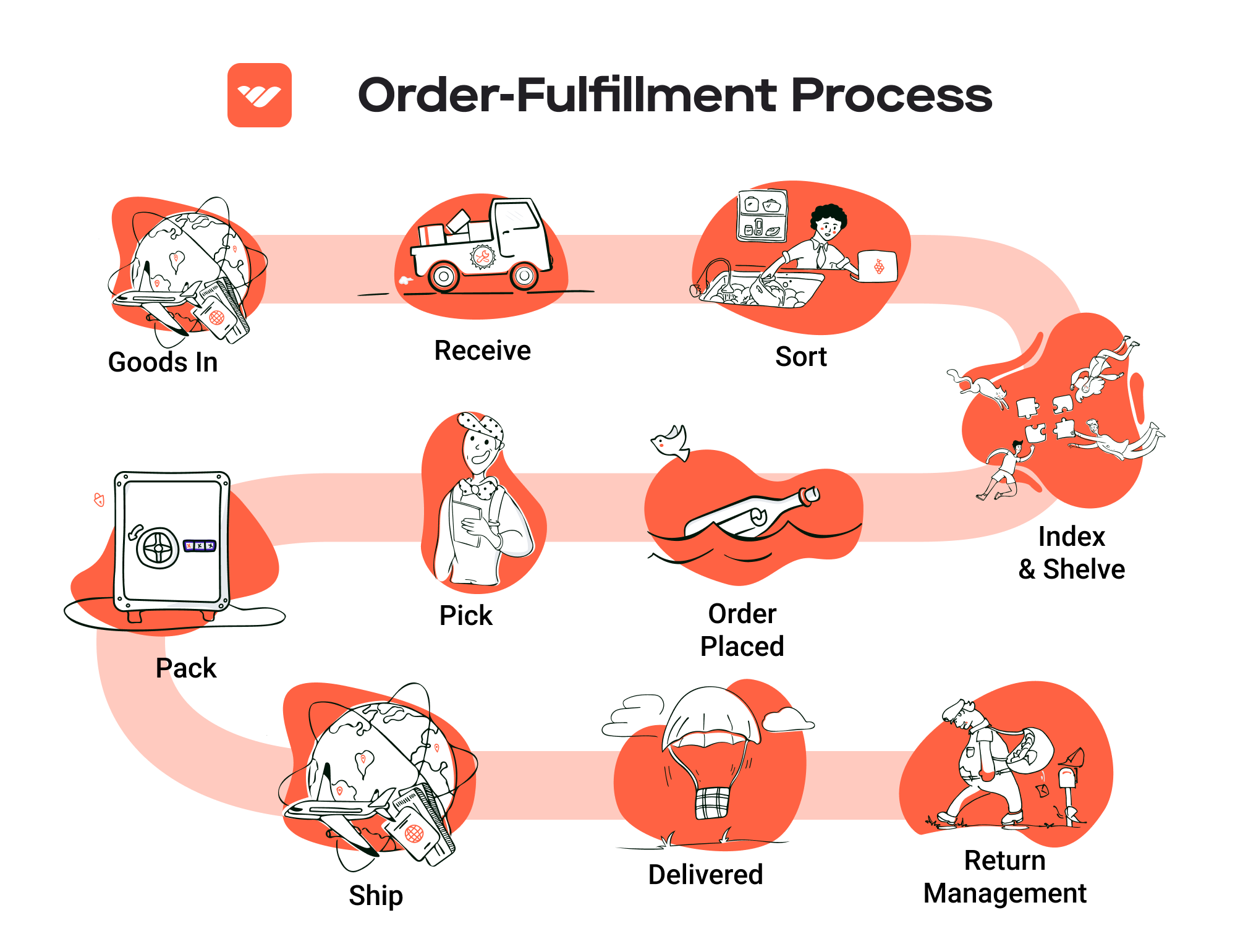
5. Shipping & Delivery
The final step in the order fulfillment process is shipping and delivery. This involves selecting the appropriate carrier, generating shipping labels, and dispatching the package to the customer. The speed and reliability of this step are crucial for customer satisfaction and can significantly influence repeat business.
A key term here is last mile delivery, which refers to the final leg of the shipping process from a distribution center to the customer’s door. Efficient last mile delivery is critical as it often represents the most significant portion of shipping costs and can impact delivery times.
Businesses should evaluate various shipping options and partnerships to find the most cost-effective and reliable carriers. Utilizing tracking systems allows customers to monitor their packages in real-time, enhancing transparency and trust in the fulfillment process.
In conclusion, mastering the order fulfillment process is essential for e-commerce businesses looking to scale. By focusing on each step—from receiving inventory to shipping and delivery—businesses can improve operational efficiency, reduce costs, and ultimately provide a superior customer experience.
Comparing Fulfillment Models: In-House vs. 3PL vs. Dropshipping
Fulfillment Model Comparison
| Model | Who Handles Inventory | Best For (Business Stage) | Key Advantage | Key Disadvantage |
|---|---|---|---|---|
| In-House Fulfillment | The business itself | Established businesses | Complete control over inventory and operations | Higher overhead costs and resource-intensive |
| Third-Party Logistics (3PL) | A separate logistics provider | Growing businesses | Scalability and reduced operational burden | Less control over inventory management |
| Dropshipping | Supplier or manufacturer | Startups or niche products | Low upfront investment and no inventory risk | Lower profit margins and potential supplier issues |
In-House Fulfillment
In-house fulfillment is a model where the business manages its own warehousing, inventory, and order processing. This model is typically best suited for established businesses that have the resources and infrastructure to handle fulfillment internally. One of the key advantages of in-house fulfillment is the complete control it offers over inventory management, shipping processes, and customer service. Businesses can tailor their fulfillment strategies to align closely with their brand values and customer expectations. However, this model can also lead to higher overhead costs, including staffing, warehousing, and technology investments. Additionally, managing logistics in-house can be resource-intensive, often requiring significant time and effort that could be allocated to other areas of the business, such as marketing or product development.
Third-Party Logistics (3PL)
Third-party logistics (3PL) refers to outsourcing the logistics operations to a specialized provider that handles storage, inventory management, and shipping. This model is particularly beneficial for growing businesses that are scaling quickly and need to optimize their fulfillment processes without the burden of managing logistics directly. One of the primary advantages of using a 3PL is the scalability it provides; businesses can adjust their logistics needs based on fluctuating demand without investing in additional infrastructure. Moreover, 3PL providers often have established relationships with carriers and advanced technology systems, which can lead to improved shipping rates and faster delivery times. However, one of the significant downsides is the reduced control over inventory management and fulfillment processes, which can sometimes lead to miscommunication or errors that affect customer satisfaction.
Dropshipping
Dropshipping is a fulfillment model where the retailer does not keep the products in stock but instead transfers customer orders directly to a supplier or manufacturer, who then ships the products directly to the customer. This model is ideal for startups or businesses focusing on niche products, as it requires minimal upfront investment and eliminates the risks associated with holding inventory. The key advantage of dropshipping is the low overhead costs; businesses can start selling without the need for a warehouse or inventory management system. However, dropshipping comes with its own set of challenges. Profit margins can be lower compared to other models, as suppliers often take a significant cut. Additionally, businesses may face issues related to inventory availability, shipping times, and the quality of the products, which can ultimately impact customer experience and brand reputation.
Conclusion
Choosing the right fulfillment model is critical for e-commerce businesses, especially those looking to scale. In-house fulfillment provides complete control but comes with higher costs and resource demands. Third-party logistics offer scalability and efficiency, making them suitable for growing businesses, albeit with some loss of control. Dropshipping presents an attractive low-risk entry point for new ventures but can lead to challenges in profit margins and supplier reliability. Business owners must carefully evaluate their current stage, operational capabilities, and long-term goals to select the model that best aligns with their strategy for growth and customer satisfaction.
A Deep Dive into Amazon FBA: Pros, Cons, and Who It’s For
Understanding Fulfillment by Amazon (FBA)
Fulfillment by Amazon (FBA) is a service offered by Amazon that allows e-commerce sellers to store their products in Amazon’s fulfillment centers. Amazon then takes care of storage, packaging, and shipping of the products, as well as customer service and returns. This model enables sellers to leverage Amazon’s extensive logistics network and customer trust, allowing them to focus on other aspects of their business, such as marketing and product development.
How FBA Works
-
Setup: Sellers create an Amazon seller account and enroll in the FBA program. They list their products on Amazon and set their fulfillment preferences.
-
Shipping to Amazon: Sellers ship their products to Amazon’s designated fulfillment centers. Amazon provides guidance on how to prepare and package the items for shipment.
-
Storage: Once the products arrive at the fulfillment center, they are stored until sold. Amazon manages inventory and storage space efficiently.
-
Order Processing: When a customer orders a product, Amazon handles the picking, packing, and shipping of the item directly to the customer. This process is designed to be fast and efficient, often allowing for same-day or next-day delivery for Prime members.
-
Customer Service: Amazon also manages customer inquiries and returns related to FBA products, providing sellers with peace of mind and saving them time.
-
Payment: After a sale, Amazon deducts its fees from the sale price and transfers the remaining amount to the seller’s account, usually on a bi-weekly basis.
Pros of Fulfillment by Amazon
-
Prime Eligibility: One of the biggest advantages of FBA is that products become eligible for Amazon Prime, which can significantly increase visibility and sales. Prime members are more likely to purchase items with free two-day shipping, enhancing the competitiveness of FBA sellers.
-
Customer Trust: By using FBA, sellers benefit from Amazon’s established reputation for reliability and excellent customer service. Customers are more inclined to buy from sellers utilizing FBA due to the assurance of fast shipping and responsive customer support.
-
Multi-Channel Fulfillment: FBA can be used not just for sales on Amazon but also for orders from other sales channels, such as eBay or the seller’s own website. This allows for a streamlined fulfillment process across multiple platforms, consolidating logistics and inventory management.
-
Scalability: As sellers grow their businesses, FBA allows them to scale without needing to invest heavily in warehousing and logistics. Amazon handles logistics, enabling sellers to focus on growth strategies.
-
Inventory Management: Amazon provides tools and reports to help sellers manage their inventory effectively, reducing the risk of stockouts or overstocking.
Cons of Fulfillment by Amazon
-
High Fees: FBA comes with various fees, including storage fees, fulfillment fees, and additional costs for long-term storage. These fees can quickly add up, especially for sellers with lower-margin products, impacting profitability.
-
Strict Inventory Rules: Amazon has stringent inventory policies, including guidelines for how products should be packed and labeled. Failure to comply can result in additional fees or even account suspension.
-
Commingling Risks: Amazon commingles inventory from different sellers, which can lead to issues if a seller’s products are mixed with those from lower-quality suppliers. This can affect brand reputation and customer satisfaction if customers receive items that do not meet their expectations.
-
Limited Control: Once products are in Amazon’s fulfillment centers, sellers have limited control over the fulfillment process. This lack of control can be concerning for sellers who prioritize specific branding or packaging requirements.
-
Complexity in Returns: While Amazon handles returns, the process can be complex for sellers. Returned items may not always be in resalable condition, leading to additional losses.
Who is FBA Best For?
Fulfillment by Amazon is particularly beneficial for:
-
Small to Medium-Sized Businesses: Sellers looking to scale their operations without the overhead of managing logistics can find FBA a practical solution.
-
E-commerce Entrepreneurs: Those who want to focus on product sourcing and marketing, rather than fulfillment logistics, will appreciate the hands-off nature of FBA.
-
Sellers with High Demand Products: If a seller has products that are likely to sell quickly and benefit from Prime eligibility, FBA can enhance visibility and sales velocity.
-
Brands with Established Customer Trust: Sellers who already have a customer base or brand recognition may find that FBA enhances their reputation through Amazon’s customer service and fast shipping.
-
Multi-Channel Sellers: Businesses that sell on multiple platforms and want to streamline their fulfillment process can leverage FBA for efficiency across their sales channels.
In summary, Fulfillment by Amazon offers a robust solution for e-commerce sellers looking to optimize their logistics and customer experience. However, potential users should carefully consider the costs and limitations associated with the program to ensure it aligns with their business goals.
Core Services Offered by Fulfillment Centers
Inventory Management & Warehousing
Inventory management is the cornerstone of any successful e-commerce operation. Fulfillment centers provide comprehensive inventory management services that include tracking stock levels, forecasting demand, and optimizing storage. By utilizing advanced inventory management systems, fulfillment centers ensure that businesses maintain optimal stock levels, preventing both overstock and stockouts.
Benefits:
– Efficiency: Automated inventory tracking reduces manual errors and saves time, allowing businesses to focus on growth rather than logistical hassles.
– Cost Savings: By optimizing inventory levels, businesses can reduce carrying costs associated with excess inventory and avoid lost sales due to stockouts.
– Data-Driven Decisions: Fulfillment centers often provide analytics and reporting tools that help businesses make informed decisions based on real-time data, improving overall supply chain efficiency.
Pick and Pack Services
Pick and pack services involve the selection (picking) of items from inventory and packaging them for shipment to customers. Fulfillment centers utilize streamlined processes and trained staff to efficiently handle this critical step in the order fulfillment process. This service typically includes quality checks to ensure that the correct items are packed and shipped.
Benefits:
– Speed: With dedicated staff and optimized workflows, fulfillment centers can significantly reduce order processing times, enabling faster delivery to customers.
– Accuracy: Professional pick and pack services minimize errors, which enhances customer satisfaction and reduces returns due to incorrect shipments.
– Scalability: As e-commerce businesses grow, fulfillment centers can quickly adapt to increasing order volumes without the need for businesses to invest in additional resources or infrastructure.
Kitting and Assembly
Kitting and assembly services allow businesses to combine multiple products into a single package or create customized bundles tailored to specific customer needs. This can involve assembling items together or packaging them as promotional kits. Fulfillment centers handle the labor-intensive tasks of kitting and assembly, allowing businesses to offer unique product combinations without the associated logistical challenges.
Benefits:
– Customization: Businesses can offer personalized products or bundles, enhancing the customer experience and increasing perceived value.
– Operational Efficiency: By outsourcing kitting and assembly to fulfillment centers, businesses can streamline their operations, allowing them to focus on core competencies like marketing and customer service.
– Inventory Control: Fulfillment centers manage the inventory of both individual items and kits, providing businesses with a clear view of stock levels and helping to prevent over-committing on bundled products.
Returns Management (Reverse Logistics)
Returns management, often referred to as reverse logistics, is an essential service provided by fulfillment centers. This process involves handling returned items, assessing their condition, restocking, or processing them for resale, recycling, or disposal. An efficient returns management system can turn potential losses into opportunities for customer retention and satisfaction.
Benefits:
– Enhanced Customer Experience: A streamlined returns process makes it easier for customers to return items, improving overall satisfaction and encouraging repeat business.
– Cost Efficiency: Fulfillment centers can assess the condition of returned items and determine the best course of action, whether it be restocking, refurbishing, or recycling, thus minimizing losses.
– Data Insights: Analyzing return data can provide valuable insights into customer preferences and product quality, allowing businesses to make informed decisions about product offerings and marketing strategies.
In conclusion, partnering with a fulfillment center offers e-commerce businesses a range of core services that can streamline operations, enhance customer satisfaction, and ultimately drive growth. By leveraging these services, businesses can focus on scaling their sales and enhancing their brand, while leaving the complexities of logistics and fulfillment to the experts.
How to Choose a Fulfillment Partner: A 6-Point Checklist
Location & Warehouse Network
Choosing a fulfillment partner with strategically located warehouses is crucial for reducing shipping times and costs. A well-distributed network allows for faster delivery to your customer base, which is increasingly important in today’s e-commerce landscape.
Questions to Ask:
– Where are your fulfillment centers located, and how do they align with my customer demographics?
– What is the average shipping time from each location to my primary markets?
– Do you have plans to expand or optimize your warehouse network in the near future?
Technology & Integrations
In a digital-first world, your fulfillment partner’s technology can make or break your operations. The right systems can streamline order processing, inventory management, and customer communication. Look for partners that offer robust integrations with your existing e-commerce platforms and tools.
Questions to Ask:
– What technology do you use for inventory management and order tracking?
– Can your systems integrate with my e-commerce platform (e.g., Shopify, WooCommerce)?
– How do you handle data security and backups?
Specializations (e.g., Cold Storage, Oversized Items)
Not all products require the same handling. If your inventory includes specialty items like perishables or oversized products, ensure your fulfillment partner has the necessary capabilities and experience to manage them effectively.
Questions to Ask:
– What types of specialized storage do you offer (e.g., cold storage, hazardous materials)?
– Can you handle bulk or oversized items, and what are the additional costs associated?
– Have you worked with companies in my industry before? Can you provide case studies or references?
Scalability & Capacity
As your business grows, your fulfillment needs will evolve. It’s essential to partner with a fulfillment provider that can scale with you, accommodating fluctuations in order volume without compromising service quality.
Questions to Ask:
– How do you manage peak seasons or spikes in order volume?
– What is your current capacity, and how quickly can you expand if needed?
– Do you have contingency plans in place for unexpected demand surges?
Pricing and Contracts
Understanding the pricing structure and terms of the contract is essential to avoid unexpected costs that can erode your margins. Look for transparency in pricing models and ensure you understand what is included in the base rate versus additional fees.
Questions to Ask:
– Can you provide a detailed breakdown of your pricing structure (e.g., storage fees, pick and pack fees, shipping costs)?
– Are there any additional fees I should be aware of (e.g., for returns, special handling)?
– What is the contract length, and what are the terms for renewal or cancellation?
Customer Support & Reviews
A partner’s customer support can significantly impact your operations. Responsive, knowledgeable support can help resolve issues quickly, minimizing disruptions. Additionally, researching reviews and testimonials can provide insights into the partner’s reliability and service quality.
Questions to Ask:
– What support channels do you offer (e.g., phone, email, chat), and what are your typical response times?
– Can you provide references or case studies from current or past clients?
– How do you handle customer complaints or issues, and what is your escalation process?
Conclusion
Selecting the right fulfillment partner is a critical decision that can influence your overall business success. By following this checklist, you can ensure you choose a partner that aligns with your operational needs, supports your growth, and enhances your customer experience. Remember, this relationship is a partnership; clear communication and alignment of goals will be key to a successful collaboration.
Understanding Fulfillment Pricing: A Breakdown of Common Fees
Initial Setup Fees
Initial setup fees are typically charged by fulfillment centers when you first begin using their services. These fees cover the costs associated with onboarding your business into their system. This may include setting up your inventory in their software, integrating with your e-commerce platform, and establishing your shipping methods. The calculation of initial setup fees can vary significantly depending on the complexity of your requirements and the fulfillment center’s pricing model.
Some centers may charge a flat fee, while others may assess costs based on the number of SKUs (Stock Keeping Units) you intend to manage. As an e-commerce business owner, it’s crucial to clarify what services are included in this fee. A thorough understanding can help prevent unexpected charges down the line.
Receiving Fees
Receiving fees are charged when your inventory arrives at the fulfillment center. These fees cover the labor and resources needed to unload, inspect, and store your products. Typically, receiving fees are calculated based on the volume or weight of the shipment, or sometimes on a per-pallet basis.
For example, a fulfillment center may charge a specific amount per pallet or per hour for the labor involved in receiving your goods. It’s essential to keep in mind that discrepancies in inventory can lead to additional receiving fees, so ensure that your shipment is accurate and well-documented to avoid unexpected costs.
Storage Fees (per pallet/bin)
Storage fees are incurred for the space your inventory occupies within the fulfillment center. These fees can be assessed on a monthly basis, often calculated per pallet or bin. The specific rate will depend on factors such as the size of the pallets, the type of products stored, and the overall storage capacity of the facility.
For instance, if you have a large volume of products but only a few SKUs, you may find that your storage fees are lower than if you have numerous SKUs taking up the same amount of space. Many fulfillment centers also offer tiered pricing, where the rate decreases as you store more pallets. Understanding your inventory turnover rate can help you optimize storage costs.
Pick & Pack Fees (per item/order)
Pick & pack fees are charged for the labor involved in selecting (picking) your items from storage and preparing them for shipment (packing). This fee is often calculated on a per-item or per-order basis. The fee may vary depending on the complexity of the picking process; for example, orders that contain multiple items may incur higher fees than single-item orders.
Some fulfillment centers may also have different pricing tiers based on the type of product being picked and packed—fragile items, for instance, may require more careful handling and thus incur higher fees. As you scale your business, keeping an eye on these fees will help you identify opportunities for efficiency improvements, such as consolidating orders or optimizing packaging.
Shipping Fees
Shipping fees are one of the most significant costs in the fulfillment process, as they cover the transportation of your products from the fulfillment center to your customers. These fees can vary widely based on factors such as the shipping carrier, delivery speed, package dimensions, weight, and destination.
Fulfillment centers often negotiate shipping rates with carriers, and these savings can sometimes be passed on to you. It’s vital to understand how shipping fees are calculated and whether the fulfillment center offers options for discounted rates or flat-rate shipping. Additionally, consider the potential for using multiple carriers to find the best price for different shipping routes.
Conclusion: Tips for Getting an Accurate Quote
When seeking an accurate quote for fulfillment services, it’s essential to be as detailed as possible about your business needs. Here are some tips to help you get a precise estimate:
-
Provide Detailed Inventory Information: Include the number of SKUs, dimensions, and weight of products to ensure accurate storage and shipping fees.
-
Clarify Service Levels: Specify any additional services you may need, such as kitting, custom packaging, or special handling.
-
Ask About Pricing Structures: Inquire if fees are flat, tiered, or variable based on specific metrics. Understanding the fee structure will help you anticipate costs better.
-
Request a Breakdown of Fees: Ask for a detailed breakdown of all potential fees, including initial setup, receiving, storage, pick & pack, and shipping. This will help you identify any hidden costs.
-
Negotiate Terms: If you plan to scale your business, discuss potential discounts or better terms for higher volumes, as many fulfillment centers are willing to negotiate based on expected order volumes.
By thoroughly understanding these common fees and seeking accurate quotes, you can make informed decisions that align with your business goals while optimizing your fulfillment strategy.
Frequently Asked Questions (FAQs) about Fulfillment
1. What is the HSN Fulfillment Center?
The HSN Fulfillment Center is a specialized facility designed to manage the storage, packing, and shipping of products sold through HSN (Home Shopping Network). It plays a critical role in ensuring timely delivery and effective inventory management, catering to the needs of e-commerce customers.
2. How does the HSN Fulfillment Center differ from a traditional warehouse?
A fulfillment center is specifically designed for e-commerce operations, focusing on processing orders quickly and efficiently. Unlike traditional warehouses, which primarily store products, fulfillment centers also handle packing, shipping, and returns management. This allows businesses to streamline their logistics and improve customer satisfaction.
3. What services does the HSN Fulfillment Center offer?
The HSN Fulfillment Center offers various services, including inventory management, order processing, packing, shipping, and returns handling. These services are tailored to enhance the customer experience by ensuring that products are delivered quickly and accurately.
4. What is a Third-Party Logistics (3PL) provider, and how does it relate to HSN?
A Third-Party Logistics (3PL) provider is a company that offers outsourced logistics services, including transportation, warehousing, and fulfillment. The HSN Fulfillment Center can be considered a 3PL provider as it manages the logistics for HSN products, allowing the company to focus on its core business operations while ensuring efficient order fulfillment.
5. How much do fulfillment services typically cost?
Fulfillment service costs can vary based on several factors, including order volume, storage space, and specific services required (e.g., kitting, packaging). Generally, costs can range from $2 to $5 per order, plus storage fees that can be charged monthly or annually. It’s essential for businesses to obtain quotes from fulfillment centers to understand the pricing structure.
6. What technologies does the HSN Fulfillment Center use to manage operations?
The HSN Fulfillment Center employs advanced technologies such as inventory management systems, automated packing solutions, and real-time tracking software. These technologies help optimize operations, reduce errors, and enhance the overall efficiency of the fulfillment process.
7. How does HSN ensure fast shipping times?
HSN has implemented a multi-year fulfillment network optimization plan that includes strategically located fulfillment centers and advanced logistics technology. This plan aims to reduce delivery times by up to two days, allowing HSN to meet customer expectations for speedy shipping.
8. Can small businesses use the HSN Fulfillment Center?
While the HSN Fulfillment Center primarily serves HSN’s own products, small businesses can benefit from similar fulfillment services offered by third-party logistics providers. Many 3PLs cater to small and medium-sized enterprises, providing the same level of efficiency and scalability that larger companies enjoy.
9. What should I consider when choosing a fulfillment center?
When selecting a fulfillment center, consider factors such as location, technology capabilities, service offerings, pricing structure, and customer service reputation. It’s crucial to choose a fulfillment partner that aligns with your business needs and can scale as your business grows.
10. How can I improve my fulfillment process?
To enhance your fulfillment process, assess your current logistics operations, implement automated systems for inventory management, and choose a reliable fulfillment partner. Additionally, regularly review your shipping strategies and customer feedback to identify areas for improvement and ensure a seamless customer experience.
Conclusion: Is Outsourcing Fulfillment the Right Move for Your Business?
Evaluating the Benefits of Outsourcing Fulfillment
Outsourcing fulfillment can be a game-changer for e-commerce businesses looking to scale efficiently. The primary advantages include significant time savings, enhanced scalability, and access to specialized expertise. By outsourcing fulfillment, businesses can shift their focus from logistics to core activities such as product development and marketing. This shift not only fosters innovation but also allows for a more agile response to market changes.
Scalability is another critical benefit. As your business grows, so do your fulfillment needs. Partnering with an established fulfillment center like HSN enables you to handle increased order volumes without the need for substantial investments in infrastructure or staffing. This flexibility can be particularly advantageous during peak seasons or promotional events when order volumes can surge unexpectedly.
Moreover, outsourcing fulfillment provides access to industry expertise that can streamline operations and improve customer satisfaction. Experienced fulfillment partners have optimized systems and processes designed to reduce shipping times, consolidate packages, and minimize costs. Their insights can help you navigate the complexities of logistics more effectively than attempting to manage these challenges in-house.
Choosing the Right Fulfillment Partner
However, not all fulfillment partners are created equal. Selecting the right provider is crucial for your growth strategy. Consider factors such as their operational capabilities, technology integration, and customer service reputation. A partner that aligns with your business values and goals can significantly influence your success.
Next Steps
To determine if outsourcing fulfillment is the right move for your business, conduct a thorough audit of your current shipping and logistics processes. Assess your pain points, costs, and the time you and your team spend on fulfillment tasks. This evaluation will provide clarity on whether partnering with a fulfillment service could enhance your operational efficiency and support your growth trajectory. Take action today—your future success may depend on it.
Important Disclaimer
⚠️ Important Disclaimer
The information in this guide is for educational purposes. Fulfillment services, pricing, and platform features change frequently. Always conduct your own due diligence and consult with providers directly before making business decisions.
